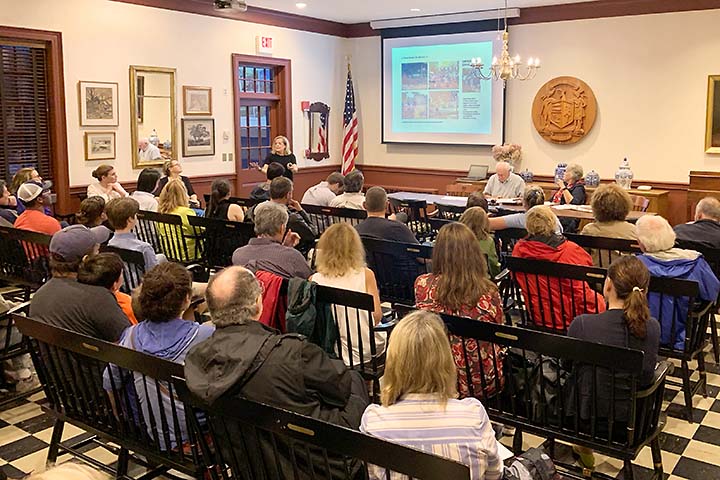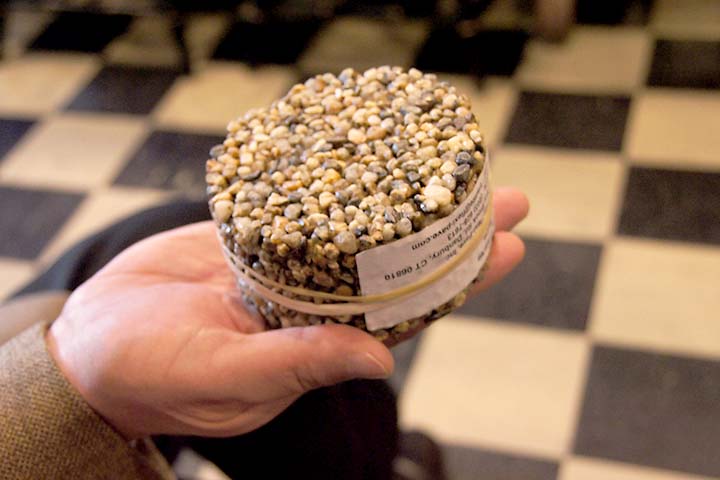Broad Support for Town Green at Commission Hearing

A proposal for a Town Green will be taken up again by the Historic District Commission on September 4 at 8:00 in the Town Hall Meeting Room. A hearing on August 7 attracted a large audience, about 65 people, the overwhelming number in support of the plan.
The meeting began with a presentation by architect Nancy Thiel, co-chair of the Beautification Committee, developer of the proposal. A short question and comment period by commissioners followed. Two commissioners, Roland Poirer and Chris Kimberly, had little to say, as they were present only by telephone, apparently with poor cellular connections. It is not clear they were able to hear what the public later had to say.
Ms. Thiel’s talk was a crisp overview of more detailed presentations delivered in previous meetings of the commission, Planning and Zoning, and the Selectmen.
Ms. Thiel described elements of the plan the public would not have seen in the published PowerPoint presentation. Landscaping will be designed pro bono by master gardener Karin Feingold, plantings are designed to support the Pollinator Pathway, veterans from wars not included in existing memorials are being identified, with the help of Weston Historical Society, so their names can appear in improved memorials. This, said Ms. Thiel, pleases the town’s Veteran’s Committee.
In addition, the proposed ellipse and walkway will make the entire area more accessible. Weston Police will finally get the signage they have long pleaded for. We know from discussions with police officials that a common and disturbing problem is that people in distress arrive at Town Hall campus in search of aid, but cannot tell where to go.
Objections
Ms. Thiel presented the first version of the plan to a sparsely-attended Historic District Commission hearing on April 3. Commissioners expressed reservations and asked for more detailed information.
On May 8, the commission rejected the application, objecting to the planned design, material, and number of benches, the style of new lampposts, and the relocation of memorials. The meeting was apparently so contentious that two of the three citizens who attended wrote to the First Selectman complaining that members had been rude and disrespectful.
This was not Ms. Thiel’s first time in front of a skeptical or hostile board. She is an experienced architect, having worked on major projects for large municipalities and corporations, including Disney. She revised her plans, as commission chairman Paul Deysenroth acknowledged last week, and on June 6 the Selectmen formally referred the application to the commission, unanimously expressing their support.
Moving Ahead “Ever So Gently”
Last week, the most vocal opponent of the plan was commissioner Lynne Langlois, who in a pre-meeting on July 10 said the proposal alters “the fabric of the town” and changes “what it has evolved to.”
That may overstate the impact of a town green, but there are clearly some in town who prefer that nothing change. That was acknowledged in the hearing, and largely respected, although one long-time resident, Amy Sanborn, noted that “just because some of us have been here a long time doesn’t mean oldtimers are against change.”
Ilene Richardson, one of the many speakers in support, said of Ms. Thiel’s design: “Everyone in the room wants what’s best for this town. You have done an amazing job of honoring what is special about this town and taking into account what people want, and to move the town forward ever so gently while still keeping what makes it so special. Don’t we want little bits of progress that are true to the town but help us move forward as a community in a better way for all of us?”
It was clear that many in the room, likely most, were aware the plan is a source of contention. Ryan Gussen, a student who had attended the May 8 meeting and appeared to be frustrated by the controversy, was pleased by the broad support. “I had lost faith in endless red tape,” he said. “After tonight, I have a lot more faith.”
There were also light moments. Jason Revzon described the obstacle course of getting a cup of coffee in the shopping center and navigating one’s way to a bench by the Library. “I’m very happy there’s a master plan,” he said. “If we can get anything done, I don’t care if this has lasers and a dolphin show, I’m for it.”
Gavin Guerra, the Weston filmmaker, praised Ms. Thiel’s work and said: “This is low hanging fruit for me. It shouldn’t be contentious. I can’t believe we’re having an argument about this.”
But there was an argument.
Bones of Contention
Ms. Langlois restated her objections, including the relocation of memorials and the planned demolition of the existing walkway to make way for a new path around an ellipse. Of the path’s permeable material, an aggregate which contains a resin binder, she said “plastic is not a good way to go.”
Ms. Langlois objects to benches being secured to concrete pads and not made of “natural materials.” She also said “this dramatic change…could be achieved much less expensively, more appropriately, and faster.”
The reference to cost surprised some observers. The commission has reportedly insisted for years that State law says its decisions do not have to take cost into account. The statute actually says nothing of the kind, and cost is not included in the criteria historic district commissions are instructed to consider.
In fact, the project would be financed by fundraising, would commence almost immediately, and be completed in a few months.
Ms. Thiel pointed out that time is already demolishing the existing walkway. She explained that benches at town greens and most parks are always secured to a surface, as their arrangement is a design feature, and having them movable would cause clutter.
She said the planned benches would have metal frames with seats made of durable ipe wood, and mentioned that both metal and wood are “natural materials.” She did not mention that resin is also a natural material. Synthetic resin, an organic compound, is a key ingredient in the making of plastic, not the other way around.

Photo: M.S. Wirtenberg. A sample of the permeable aggregate that would be used for a walkway.
Ms. Thiel also emphasized the walkway’s benefits in improving accessibility to Town Hall and campus parking lots. She seemed taken aback when Ms. Langlois dismissed those benefits by saying the Americans with Disabilities Act only requires one wheelchair-accessible entrance to Town Hall, which exists, and that the Town has discouraged people from parking in the lower lot.
Ms. Thiel asked: “Why can’t we enable people to wheelchair from the lower parking lot, and also make it easier for the community?”
An unpleasant moment arose when Ms. Langlois insisted that Ms. Thiel not answer a question by explaining the commission’s statutory role. That’s not supposed to happen at a hearing, where people are free to say whatever they want within the bounds of time and civility. Ms. Langlois cited her 30 years on the commission, and said: “We are very conversant with what is our purview.”
“But we’re not!,” shouted back members of the audience. Ms. Langlois then read a brief portion of the statute. The interruption may have left the question unanswered.
A View of the Past and of the Future
Toward the end of the meeting, Taffy Miller, a member of the Board of Education, drew together key points of those who favor the plan. She agreed with Mr. Guerra that “this is a no-brainer,” and encouraged the commission to balance history and the future.
“When we talk about things that are deeply rooted in history,” she said, “and tiny objects like benches, it’s hard to let go of them.” Referring to things that are new to us but won’t be to future generations, she said “we also have to think about what our children will remember. We have to imagine that the future holds as much importance as history does. If we hold history in full honor, we won’t do it wrong. We will do it right.”
She added that the walkway would be good not just for those in wheelchairs, but also for some older people and others who have difficulty walking. She is pleased that all veterans will be honored in the new memorials. “We’re not tearing down memorials, we’re improving them.”
“We’re not destroying a place to gather,” she said. “We’re creating a new and better one.”
She noted that the project being paid for with raised funds “should not be underestimated. It indicates there is civic engagement from the people of Weston to make this happen. That alone is a signal that people love this place, and want to see it grow.”
The Path Forward
On September 4, the commission will discuss the matter and decide whether to issue a Certificate of Appropriateness. This they must do unless they find, and can justify in detail, that the proposed Town Green is, in the language of the statute, “incongruous” with the characteristics of the Norfield Historic District.
There have been instances, going back some time, where historic district commissions have not been averse to bucking the preferences of town governments. Not that long ago, controversy erupted in Weston when the commission prevented the use of inexpensive roofing materials on campus buildings, finding them “incongruous.”
Only last year, this commission signalled an intention to require that cedar roof shingles be used in a Library roof replacement instead of relatively inexpensive asphalt material. This infuriated the late Selectman Brian Gordon, who found the added expense and shorter lifespan of cedar unconscionable at a time the Town’s budget and tax rate were under great pressure.
Mr. Gordon wanted the Board of Selectmen to consider removing the Town Hall campus from the historic district, a measure the Board did explore later in the year, eventually deciding not to do so, at least for now.
The relationship between a historic district commission and a town government represents one of the odd properties of small-town Connecticut government. Members are appointed — and can be removed — by the Selectmen, but their powers, vested by the State, give them the ability to defy the Selectmen’s will, at least to a point. The Conservation Commission has similar statutory leverage. So do the Board of Finance and, to a limited degree, the Planning and Zoning Commission. But their members are elected.
The matter of the Library roof was effectively tabled as plans progress to add a new wing to the building, funded by a gift from the estate of Daniel Offutt. It appears the plan will come to the Historic District Commission before too long. That discussion promises to be lively.
Previous article on this topic:
August 5, 2019: "Town Green Plan Hearing, August 7"
